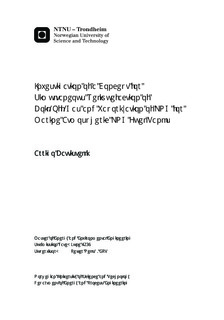Investigation of a Concept for Simultaneous Reliquefaction of Boil-Off-Gas and Vaporization of LNG for Marine Atmospheric LNG Fuel Tanks
Master thesis
Permanent lenke
http://hdl.handle.net/11250/257789Utgivelsesdato
2014Metadata
Vis full innførselSamlinger
- Institutt for elkraftteknikk [2468]
Sammendrag
The aim of this thesis is to design and optimize a heat pump process to reliquefy Boil-Off-Gas from Liquefied Natural Gas (LNG) cryogenic tanks, and simulataneously vaporize LNG at high pressure.The process is meant for use onboard LNG fuelled ship different from LNG carriers, equipped with LNG fuel tanks at atmospheric pressure and 2-strokes engines with high pressure gas injection, which is considered the most efficient propulsion arrangement for medium-large vessels.The studyis based on a patented concept from the norwegian companyLNG New Technlogies, within the thesis this concept is evolved to a more complex process layout, its distinctive features are low temperature suction of the heat pump refrigerant compressor, absence of heat discharge to the environment and condensation of the Boil-Off-Gas via recirculation of subcooled LNG. Four different operating scenarios of the process are simulated with the commercial software HYSYS® , the results of the simulations are presented in the form of case studies, sensitivity analyses, thermodynamic diagrams and tables, and analized in detail. Anumber of modifications to the selected layout are evaluated, e.g. Boil-Off-Gas feed to the Auxiliaryengine and compressor intercooling. Based on the simulation results a preliminary selection ofthe process equipment is outlined, with focus on the refrigerant compressor.The results prove that the proposed heat pump process can effectively refrigerate the LNG tank if the ship is operating in the normal mode or at half of the main engine load, however at lower engine loads, especially when the main engine is shut down, the system can not produce the required refrigeration effect. In this scenario the excess Boil-Off-Gas would be fed to the Auxiliary engines, or in the worst case burnt in Gas Combustion Units. The heat pump efficiency for the normal operation is 2-3 times higher than for commercial on-board Boil-Off-Gas reliquefaction processes, but the maximumreliquefaction capacity is intrinsically lower. The operating parameters of the compressor suggest the use of a reciprocating oil-free compressor with cryogenic material specifications, this is considered the most non-conventional and costly unit of the process.
